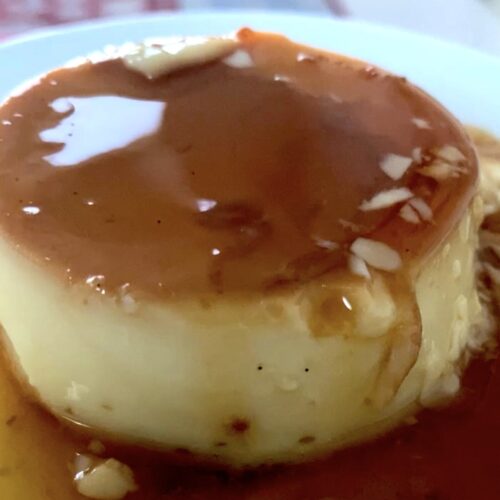Have I ever told you about my godmother? She was my grandmother's best friend (they lived a couple doors down from each other), and was one of the most influential people in my life when it came to cooking. I remember standing on my tippy toes, teetering precariously on a stool, in her kitchen watching her stir a sauce, the fragrance enveloping her and mixing effortlessly with her perfume. She always smelled of butter, fresh herbs and lilac. Crème caramel was one of the first dishes I remember making with her. I was in charge of whisking the eggs while she made the caramel in a heavy copper pot she'd carried with her from France. And, yep, I'm fully aware of how annoying some of these stories are and how food bloggers get called out for not getting "right to the recipe". But this recipe is a piece of my godmother, and a piece of my heart. It reminds me of her every time I make it. I hear her lilting accent encouraging me, guiding me and can still see her giving me a "chef's kiss" the first time I made this all by myself. I think she'd be really thrilled to see it here and have it shared with you. Bon Appetit, friends.

Now for your questions.......if I don't answer them here, you can always leave a comment below and I'll be happy to answer any questions you have!
Do I have to make caramel sauce?
Well, since caramel is literally in the name of the dish, yep, you need to have caramel. BUT there is a little shortcut. I tried this dish by sprinkling a tablespoon of dark brown sugar in the bottom of each ramekin before adding the custard. It wasn't traditional caramel, but the dark brown sugar mimicked a lot of the characteristics of caramel. If you're short on time, try the brown sugar and let me know what you think!
Can I make this without eggs/milk/cream?
I know there are recipes that use condensed milk, but that will make the consistency of your crème caramel a lot heavier and thicker. But, like I always say, try using condensed milk or coconut milk and see what happens. We learn so much when we have the courage to try......and if it works, let me know!! And if it doesn't, oh well! Trust me, I've had loads of complete failures and disasters in the kitchen, but they've all taught me something. (like there is such a thing as adding too much harissa.....but that's a story for another time!)
How long will this last?
Because of the eggs and milk, I wouldn't keep it more than 4 days.
Can I make this in one large dish?
Yes! You don't have to make this in ramekins. You can make this in a pie dish, pyrex dish or even a loaf pan. Depending on the size and depth, you'll need to add extra time, probably about an extra 10 minutes. You'll still need to bake it in a large roasting pan and ban marie (water bath), so whatever you vessel you want to bake it in, be sure it fits in your larger roasting pan.
Isn't this the same thing as crème brûlée?
Not really. Crème caramel is a light, smooth creamy texture and is crème brûlée has a thicker more custard like texture with a sugar top that's burnt to make a hard candy crust.


No Comments